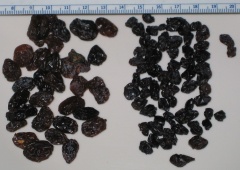Raisins
| Infobox on Raisins | |
|---|---|
| Example of Raisins |  |
| Facts | |
| Origin | This table shows only a selection of the most important countries of origin and should not be thought of as exhaustive.
|
| Stowage factor (in m3/t) |
|
| Humidity / moisture |
|
| Ventilation | If the product is at "shipping dryness", i.e. if there is no risk of degradation by mold etc. due to water content, ventilation is not required. If this is not the case, the following ventilation measures should be implemented: air exchange rate: 6 changes/hour (airing). |
| Risk factors | Currants are very frequently infested by pests. A fumigation certificate must be provided. Sensitive to wet damage. |
Raisins
Description
Raisins are dried grapes. They are produced in many regions of the world. Raisins may be eaten raw or used in cooking, baking and brewing. In the United Kingdom, Ireland, New Zealand, Australia, and Canada the word "raisin" is reserved for the dried large dark grape, with "sultana" being a dried large white grape, and "currant" being a dried small Black Corinth grape.
Raisin varieties depend on the type of grape used, and are made in a variety of sizes and colors including green, black, blue, purple, and yellow. Seedless varieties include the sultana (also known as Thompson Seedless in the USA) and Flame grapes. Raisins are typically sun-dried, but may also be water-dipped, or dehydrated. "Golden raisins" are made from sultanas, treated with sulfur dioxide (SO2), and flame-dried to give them their characteristic color. A particular variety of seedless grape, the Black Corinth, is also sun-dried to produce Zante currants, miniature raisins that are much darker in color and have a tart, tangy flavor. Several varieties of raisins are produced in Asia and, in the West, are only available at ethnic specialty grocers. Green raisins are produced in Iran.
Raisins range from about 67% to 72% sugars by weight, most of which is fructose and glucose. They also contain about 3% protein and 3.5% dietary fibre. Raisins, like prunes and Apricots, are also high in certain antioxidants, but have a lower vitamin C content than fresh grapes. Raisins are low in sodium and contain no cholesterol.
Raisins are sweet due to their high concentration of sugars (about 30 g of fructose and 28 g of glucose in 100 g of raisins). The sugars can crystallize inside the fruit when stored after a long period, making the dry raisins gritty, but that does not affect their usability. These sugar grains can be dissolved by blanching the fruit in hot water or other liquids.
The grapes remain on the vine until they are overripe and, after picking, are dried. Some are bleached by sulfuring (sulfur dioxide, SO2) and such treatment must be indicated on the packaging.
In order to prevent the raisins from agglomerating (sticking together), they may be treated with vegetable oil.
Applications
Raisins are intended to be eaten raw and are used as an ingredient in nut mixes, bakery products, muesli and desserts.
Shipment / Storage / Usage
Raisins are normally shipped in boxes, also in wooden crates and/or bags. Raisins should be free of mold and foreign matter (stalks, sand, pests, especially mites) and be clean. They are graded by color and size. The lightest possible color is desired.
Mould is encouraged by high humidity and possible wetting before shipment. Improper drying may also lead to mould, making the raisins inedible. Heat and pressure will cause crystallization and lumping together. Dressing with a vegetable oil lessens the danger of lumping. Raisins should be stowed away from wet, moist and odorous goods.
At 4 – 20°C and 65% relative humidity, the maximum storage duration of raisins is approx. one year.
At temperatures < 10°C, mite growth is inhibited.
Risk factors
- Wetness / Mould
- Odor
- Contamination
- Mechanical influences
- Toxicity / Hazards to health
- Shrinkage / Shortage
- Insect infestation / Diseases











